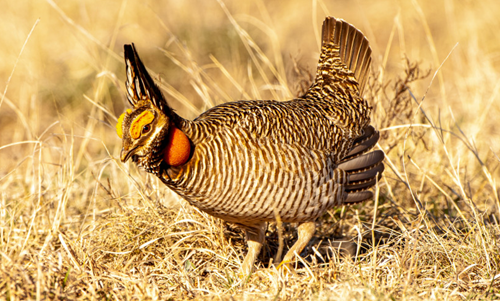AMARILLO, Texas — The United States District Court for the Western District of Texas issued an order last week vacating the United States Fish and Wildlife Service (“FWS”) listing of the lesser prairie-chicken under the Endangered Species Act.
Factual Background
The lesser prairie-chicken is a bird historically found in parts of Colorado, Kansas, Oklahoma, Texas, and New Mexico. The bird has faced both habitat loss and population decline since the 1960’s, and has found itself the subject of proposed Endangered Species Act protections.
In 2014, FWS listed the lesser prairie-chicken as threatened under the Endangered Species Act. Numerous lawsuits were filed, and the listing was ultimately vacated by the United States District Court for the Western District of Texas in 2015.
In 2016, another petition was filed with FWS to list the lesser prairie-chicken under the Endangered Species Act. In 2022, the FWS finalized a rule listing the Northern Distinct Population Segment as threatened and the Southern Distinct Population Segment as endangered. In March 2023, the State of Texas and the Permian Basin Petroleum Association filed suit challenging the listing. Specifically, they claimed the listing violated both the Endangered Species Act and the Administrative Procedures Act.
Following the Administration change in January 2025, the FWS re-evaluated the listing, and found it erred in passing the final rule listing the lesser prairie-chicken. FWS now believes it erred by failing to provide sufficient justification to have two population segments of the lesser prairie-chicken, which then affected the assessment of extinction risk to the species. This, FWS believes, was a significant error justifying immediate vacatur of the listing decision. FWS moved for a voluntary vacatur and remand of the listing rule.
Several groups sought to intervene in the lawsuit to defend the listing rule.
Court’s Decision
The court addressed two separate issues: the proper remedy and the motions to intervene.
The proper remedy
The law makes clear a court must set aside agency action that is arbitrary or capricious, contrary to the constitution, or without observance of the procedure required by law. In most cases, the manner in which such rule is to be set aside is by vacatur, although in “rare cases” a rule may be remanded to allow correction of the rule’s defects.
The court found FWS’ vacatur request complies with the requirements of the APA for setting aside agency action. FWS admits there was inadequate information to justify finding two distinct population segments, and doing so caused a problem in how the extinction risk of the species was analyzed under the Endangered Species Act. FWS persuaded the court this was not a “rare case” in which the error could be cured by remand of the rule alone. This is because the error FWS identified was foundational and “taints the findings… so significantly that a full reconsideration is warranted.” FWS will be required to undergo an entirely new analysis to cure this issue.
Additionally, the court noted the disruptive consequences of vacating the rule would be “short lived and minimized” by existing voluntary conservation programs. FWS estimates it can complete a new finding by November 2026. The existing voluntary conservation programs are intended to directly mitigate threats to the lesser prairie-chicken and its environment.
Motions to Intervene
The court denied several motions to intervene.
First, the court considered a motion to intervene filed by the Center for Biological Diversity and the Texas Campaign for the Environment finding the request untimely, unnecessary as they fail to explain their role, and the would-be intervenors fail to rebut the presumption that FWS can represent their interest. They could have filed an amicus brief, but the court did not believe they were entitled to intervene in a conceded-to case.
The court next turned to a motion to intervene filed by the LPC Conservation LLC, which it denied after noting it was “wrought with issues.” The court found the most serious to be that LPC cited no cases supporting its right to intervene in the case.
Key Takeaways
This case is extremely important for landowners, agricultural producers, oil and gas companies, and others across the portions of the United States where the lesser prairie-chickens are located, including Texas, New Mexico, Colorado, Oklahoma and Kansas. As of now, the lesser prairie-chicken is not listed under the Endangered Species Act, and there is no threat of liability under the Endangered Species Act for a “take” of these animals.
Importantly, the story is not over. The FWS will now reconsider the 2016 application to have the lesser prairie-chicken listed. It will determine how properly to view the distinction population segment, and then analyze the various factors required under the Endangered Species Act in making its listing decision. The FWS told the court it expected to have this completed by November 2026.
— Tiffany Dowell Lashmet, Texas Agriculture Law Blog
Texas A&M AgriLife Extension










